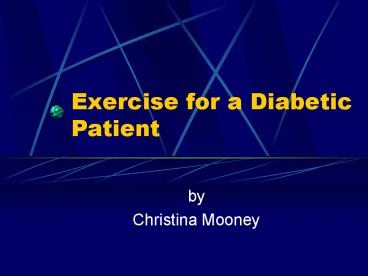Exercise for a Diabetic Patient - PowerPoint PPT Presentation
1 / 18
Title:
Exercise for a Diabetic Patient
Description:
Do not take insulin in extremity 1 hour prior to exercise ... Campaigne, B. N., (1994), Exercise in the Clinical Management of Diabetes. ... – PowerPoint PPT presentation
Number of Views:2372
Avg rating:3.0/5.0
Title: Exercise for a Diabetic Patient
1
Exercise for a Diabetic Patient
- by
- Christina Mooney
2
Diabetes Mellitus
- First described in India in 400 B.C.
- Interference with insulin production or insulin
resistance - Neuropathy
- Foot care
3
Diabetes Mellitus (cont.)
- Type I
- Insulin-dependent-diabetes mellitus
- Type II
- Non insulin-dependent diabetes mellitus
4
Diabetes Prevalence
- Increased in inactive societies
- 16 million Americans (6.5)
5
Effects of exercise on Diabetes
- Initial lowering blood glucose levels
- increase in blood glucagons levels if exercise is
prolonged or if stress hormones are released - increase sensitivity of insulin receptors to
decreased amounts of insulin for many hours - 2
days - Improvements in BG control for Type II and less
so in Type I
6
Benefits of Exercise
- Improvements in
- Skeletal muscle mass
- Blood supply
- Cardiovascular fitness
- Peripheral insulin sensitivity
- Weight control
- Psychological well-being
- Improve quality of life
- Decrease in insulin requirements for Type II
7
Risk
- Injury (increased recovery time)
- Pre-existing complications
- proliferative retinopathy
- Foot problems
- Hyperglycemia
- Hypoglycemia
8
Risk (cont.)
- Hyperglycemia
- Flushed dry skin
- Fruity breath
- Low BP
- Increase Pulse
- Confused
- Increase thirst
- Hypoglycemia
- Weakness
- Sweaty skin
- Rapid heartbeat
- Feeling shaky
- Dizzy
- hunger
9
Hyperglycemic Prevention
- exercise not recommended if BG 240 mg/dL
10
Hypoglycemia Prevention
- Insulin needs to be taken in abdomen
- Do not take insulin in extremity 1 hour prior to
exercise - Decrease insulin dosage or increase food intake
- Avoid exercising at peek insulin levels
11
Hypoglycemia Prevention (cont.)
- Test Blood Glucose levels prior to and during
exercise - Eat carbohydrate if BG
- Eat before, during and after exercise
- Do not exercise in the evening
- Increase nocturnal hypoglycemia
12
Exercise Testing
- Required physicians approval
- BG under good control
- Healthy feet
- Required exercise stress test rule out
cardiovascular complication with ECG - 35 years old
13
Exercise Recommendations
- Types that require glucose and oxygen
- Increase HR and BP (unless proliferative
retinopathy present) - Consistent routine of exercise, eating and
medication administration - Carrying exercise kit
14
Exercises not recommended
- High impact Exercises that cause jarring
- High intensity for prolonged time
- Contact sports
15
Exercise Goals
- Increase control of BG levels
- Increase blood circulation
- Weight loss for Type II
16
Exercise Prescription
- Low-intensity, long-duration (weight loss)
- Endurance
- 50-60 VO2 max
- Work up to 60-70 VO2 max
- 4-6 days/week (daily if low to moderate
intensity) - 20-30 min Type I
- 40-60 min Type II
17
(No Transcript)
18
References
- Balady, G.J., et al., (2000) ACSM Guidelines for
Exercise Testing and Prescription 6th ed. New
York Wolters Kluwer - Campaigne, B. N., (1994), Exercise in the
Clinical Management of Diabetes. Champaign Human
Kinetics - Cotton, R. T., (1998), Exercise for Older Adults.
San Diego American Council on Exercise - Gordon, G. F., (1993) Diabetes, Your complete
Exercise Guide. Dallas Human Kinetics Publishers - International Diabetes Center Safe and Healthy
Exercise for People with Diabetes 2001, ISBN
1-885115-58-x - McMurray, R. G., (1999), Concepts in Fitness
Programming. New York CRC Press - Roberts, S., Robergs, R., and Hanson, P., (1997).
Clinical Exercise Testing and Prescription
Theory and Application. New York, CRC Press, - Roitman, J. L. (ed)., (1998), ACSMs Resource
Manual for Guidelines for Exercise Testing and
Prescription. (3rd ed). New York Lippincott
Williams Wilkins - Skinner, J. S., (1993), Exercise Testing and
Exercise Prescription for Special Cases.
Baltimore Williams Wilkins































